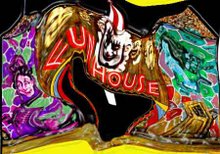Israel Museum
We loaded into the bus and headed over to the Israel Museum, an eclectic collection of just about everything you could imagine, art, culture, history, you name it!
Of course I always see interesting things on the way like this crusader type building:
or like this wind mill,
- or like this Giraffe on top of a building.
The Israel Museum was a long flat structure with a glass front.
Once you enter you go down a long hall that includes a wide variety of objects,
such as this mosaic....
or this sculpture by Rodin. (The lighting is much better for modern sculpture than it is for detailed art.)
Inside there was a special exhibit on Faces with these strange things in it.
There was so much anthropological stuff that it was overwhelming!
Those of you that visit my blog regularly know that i have a fetish for animal objects and can post endless images from museums, so here goes...
This dog head from Mesopotamia was a bit larger than a hand.
This was the top of a Roman standard.
I am fascinated with Greek pottery and the two colored slips that they use in producing the images on a third color of clay.
There were lots of objects from archaeological sites from amany different cultures and periods.
There was also a special section on Judaica.
I thought this was particularly delicate and lovely.
You know my fascination with mosaics and animals This is a detail from a very long piece that they had mounted onthe wall.
They also had a special exhibit on Cats and Dogs.
They had intersting art and then some stuff that was just weird.
This cat/dog pillow for kids to lean on falls under the weird category.
Here is some of the art.
And maybe this is some of both.
Here was the grave of a woman buried with her pet.
and this is a pretty well known photograph!
These are implements for making one beautiful.
There was a lso a very lovely room with antique glass of all kinds.
And coins were also covered.
A more modern room took the theme of Being at home and worked numerous well known works into the appropriate rooms.
Here's Andy Warhol in the kitchen area.
And Murikami overlooks the children's room.
In the Judaica rooms there were some gorgeous clothing and textiles.
They also had a special exhibit on Wei Wei. They had both his trees and his room full of sun flower seeds.
The walls are covered with the IOUs Weiwei wrote after Chinese donors raised millions of dollars to help him pay his "taxes" when he was given 15 days to pay. They raised the money in 10 days!
This is a glimpse into the Room that focuses on "Design".
Another special exhibit I found interesting was by Ilit Azoulay, who has used the Storerooms of the Israel Museum to craft collages on the subject of "No Thing Dies".
Here are a few of her pieces.
After a while it got to be too much, so I headed outside to look at the giant model of Jerusalem and also to find the museum for the Dead Sea Scrolls. You can see how immense this model is.
The museum for the Dead Sea Scrolls is under this dome.
You can't take pictures in there but here is an image from AllaboutJerusalem.com that shows the interior. (I don't actually remember it looking like that, but my focus was on the cases of manuscripts (and it was dark.))
There was also a sculpture garden that seemed a bit derelict.
It had the famous OHEVA (Love) statue mounted on the hill overlooking the city. That was pretty cool!
As I was coming back from it an old guy came rushing over to me to tell me I couldn't be there. Evidently the sculpture garden was closed. So I apologized and headed out.
It was actually time to leave anyway. I bought my earrings at the museum store and then went back to join the group waiting for the bus.



























































































